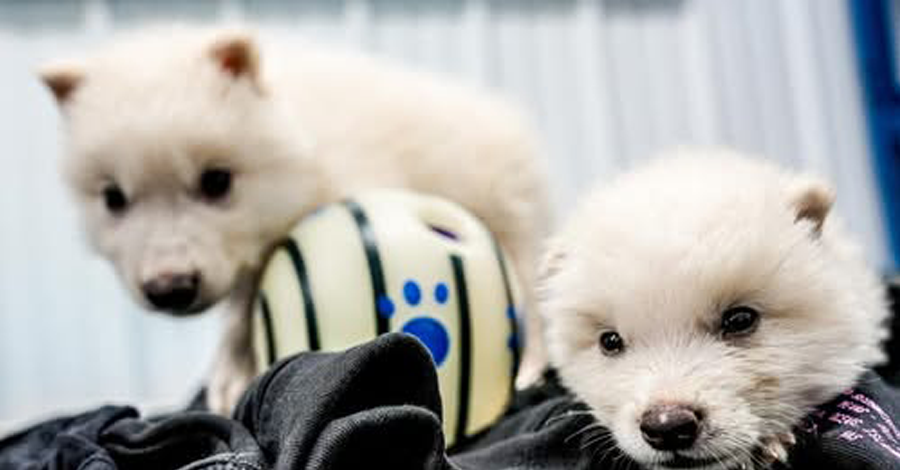Research Company brings the DIRE Wolf back to life after 12,000 Years! – Animalpond

BUT Perhaps we would be better served to bring back those animals that mankind has made [ex.tinct] and working to save those that are on the [br.ink].
Three dire wolf pups – two boys and a girl – were successfully birthed back in October. DALLAS — A biology research company based in North Texas says it’s brought a legendary creature back from [ex.tinction] after more than 12,000 years.
Dallas-based Colossal Biosciences, which describes itself as the “world’s only de-[ex.tin.ction] company,” has announced the rebirth of the once-[ex.tinct] dire wolf. Dire wolves, made famous by “Game of Thrones,” were an American canid that were as much as 25% larger than gray wolves. They had previously been [ex.tinct] for over 12,500 years.
But now, Colossal says three dire wolf pups are thriving: I could not be more proud of the team. This massive milestone is the first of many coming examples demonstrating that our end-to-end de-[ex.tinction] technology stack works. Colossal CEO Ben Lamm said: Our team took DNA from a 13,000 year old tooth and a 72,000 year old skull and made healthy dire wolf puppies. It was once said, ‘any sufficiently advanced technology is indistinguishable from magic.’ Today, our team gets to unveil some of the magic they are working on and its broader impact on conservation.
The three litters of Colossal’s dire wolves include two adolescent males named Romulus and Remus, after the twins raised by wolves in Roman mythology, and one female puppy named Khaleesi, after the “Game of Thrones” character Daenerys Targaryen.
Colossal said it extracted DNA from two dire wolf fossils: a tooth from Sheridan Pit, Ohio, that is around 13,000 years old and an inner ear bone from American Falls, Idaho, that is around 72,000 years old.
The team then deeply sequenced the extracted DNA and assembled high-quality ancient genomes. Then, they compared those genomes to those from living canids like wolves, jackals and foxes and identified gene variants specific to dire wolves, including that the wolves had white coats and long, thick fur.
And then, the team performed multiplex gene editing to a donor genome from the dire wolf’s closet living relative, the gray wolf, resulting in a record 20 precise edits in 14 genes, with 15 of those edits from [ex.tinct] variants. The team then screen edited cell lines through whole genome sequencing and karyotyping, cloned high-quality cell lines using somatic cell nuclear transfer into donor egg cells, performed embryo transfer and managed interspecies surrogacy.
‘Game of Thrones’ creator responds to the rebirth of the dire wolf
Some may be surprised to learn dire wolves were ever real at all. For many, their introduction to the creature came through things like “Dungeons & Dragons,” “World of Warcraft” and, most notably, George R.R. Martin’s novel series “A Song of Ice and Fire” and its HBO adaptation “Game of Thrones.”
Martin is an investor and cultural advisor to Colossal Biosciences and called the rebirth of the dire wolf “magic.”
Martin said: Many people view dire wolves as mythical creatures that only exist in a fantasy world, but in reality, they have a rich history of contributing to the American ecosystem. I get the luxury to write about magic, but Ben [Lamm] and Colossal have created magic by bringing these majestic beasts back to our world.
Colossal said its wolves are thriving on a more than 2,000-acre secure expansive ecological preserve that has been certified by the American Humane Society and registered with the U.S. Department of Agriculture.
The company said it employs 10 full-time animal care staff to support the wolves’, and the entire preserve is enclosed by 10-foot-tall, zoo-grade fencing. Inside the preserve, the wolves are monitored through live cameras, security personnel and drone tracking.
Colossal said the preserve includes a smaller, 6-acre secure site where the dire wolves can be studied and which also includes an on-site veterinary clinic, a “wolf management facility,” an outdoor storm shelter and natural-built dents for the wolves.
The preserve will provide lifetime care, feeding and protection for Colossal’s wolves, which will be monitored and observed to assess their readiness to more into larger protected and managed care facilities. Colossal said long-term, it plans to restore dire wolves in secure and expansive ecological preserves, potentially on indigenous land.
Efforts toward red wolf recovery: In addition to the dire wolf pups, Colossal also birthed two litters of cloned red wolves – the most [cr.itic.ally en.dang.ered] wolf in the world – using what it calls a new approach to non-invasive blood cloning.
The two liters were birthed from three different genetic founder lines and include one adolescent female red wolf named Hope and three male red wolf puppies named Blaze, Cinder and Ash.
The rebirth of the dire wolf isn’t the first time that Colossal Biosciences has recently made headlines.
In March, scientists at the company said they were working to genetically engineer living animals with qualities to resemble [ex.tinct] species like the wooly mammoth.
Colossal announced its scientists had simultaneously edited seven genes in mice embryos to create mice with long, thick, wooly hair, nicknamed the “Colossal wooly mouse.”
The wooly mouse previously held the record for unique germline edits in an animal with eight precision edits, but the dire wolf pups now hold the No. 1 spot with their 20 edits.
Watch the video below:
Read more :
Pepper, E.v.ict.ed Texas Library Cat, now listed for Adoption! – Animalpond



![HEARTSTOPPING MIRACLE! Heroic K9 and Police Officer Save a newborn Swept 10km Away by [Fl.oo.dwa.ters] in Texas — Summer Camp Nig.htm.are Turns into MIRACLE! – petcutes](https://animalpond.com/wp-content/uploads/2025/07/Screenshot_1sfs-768x459.png)


![Shawnee K9 officer [st.abb.ed] during barricade incident in KCK; su.spe.ct in cu.sto.dy!](https://animalpond.com/wp-content/uploads/2025/08/Screenshot_48-768x432.png)